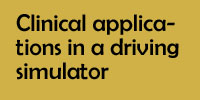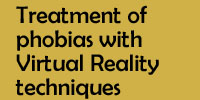A driving test simulator, can be used for various purposes. One of the most popular uses is as a driving test for professional drivers, for people who have committed traffic offences, or of assessment of driver fitness.
The clinical modules consist of 12 driving test simulations in 5 different virtual environments. There are 2 driving simulations aimed at the treatment of fear of driving. In addition there are 2 simple driving simulation tests, plus 2 practice simulations, aimed at assessment of fitness to drive, these are a brake reaction time test and a steering reaction time test. Furthermore there are 6 more complicated driving tests aimed at the assessment of driver fitness. These tests include a number of unexpected situations and driving under more demanding circumstances, for example a test to induce sleepiness and aimed at people with sleeping disorders. Click here to ask a question, order a simulator or just the software.
The driving test simulator software can be used succesfully in a number of clinical applications. These modules are available as a 3 channel rendering version:
- Module S3: Clinical modules and runtime licence, including tests for assessment of driver fitness, 3 display version software licence: €1000,-
- Module S2-3: In addition Carnetsoft offers a limited research simulator software option for use on the clinical simulations/tests and virtual environments so you can do your own research, or develop your own assessment tests. The price is €500,-. This limited research facility also allows you to modify the existing tests, for example, make them longer, generate other events and stimuli, measure different variables, etc. It contains scenario scripts generation software, data analysis module + scenario script of the 12 clinical simulations (not the road designer). It is only sold in combination with S3.
The 3-display version of the driving test simulator has a 210 degrees horizontal field of view and spans three rendering displays plus one user interface monitor.
The following clinical applications are included:
Treatment of fear of driving
A simulator is very efficient to treat fear of driving, because if lets people drive in a realistic driving environment for a prolonged time without any real risk. This module contains a highway and a town scenario that can be driven for an extended period of time. Every 5 minutes the level of tension (anxiety) is measured and although the client will experience fear at the beginning of the drive, this will reduce after some time. This technique, also known as exposure in vivo, has been proved successful in the treatment of phobias.
Fitness to drive test
The methods generally used for the assessment of fitness to drive after a CVA, at older age, sleep apnea or with various neurological conditions, often lack reliability and validity. To effectively assess fitness to drive, more is needed than the traditional eye tests and tests of urine samples. While driving test simulator are often less suitable for the assessment of driving behaviour in older people, because of the increased risk of simulator or cyber sickness in this population, when a number of precautions are being taken in the design of the tests, the risk of simulator sickness can be reduced substantially. Driving simulator tests can be a valuable addition to the set of diagnostic instruments to evaluate fitness to drive. The module consists of a number of tests that vary from measuring the brake reaction time to the measurement of workload in driving situations with varying complexity. See here for more information about the fitness to drive simulation modules..
Driver rehabilitation and occupational therapy
The driver training program contains a lot of material that can be used to evaluate driver behaviour and to train people driving skills in occupational therapy. Especially, turning at intersections, reacting to unexpected events and negotiating fourway intersections and roundabouts can be trained in this group. The driver training software licence is NOT included in the clinical applications licence.
Related blog posts:



